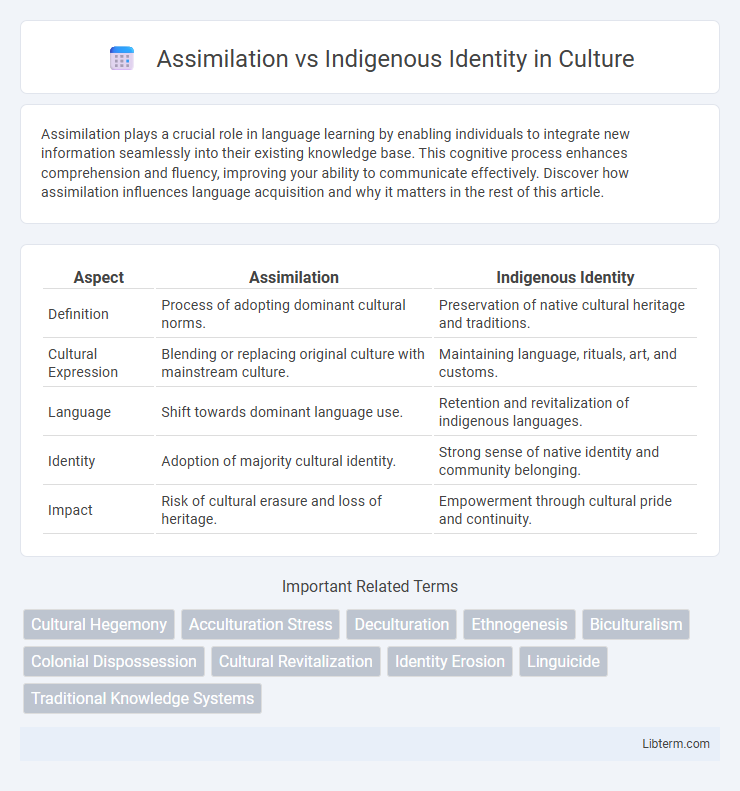Assimilation plays a crucial role in language learning by enabling individuals to integrate new information seamlessly into their existing knowledge base. This cognitive process enhances comprehension and fluency, improving your ability to communicate effectively. Discover how assimilation influences language acquisition and why it matters in the rest of this article.
Table of Comparison
| Aspect | Assimilation | Indigenous Identity |
|---|---|---|
| Definition | Process of adopting dominant cultural norms. | Preservation of native cultural heritage and traditions. |
| Cultural Expression | Blending or replacing original culture with mainstream culture. | Maintaining language, rituals, art, and customs. |
| Language | Shift towards dominant language use. | Retention and revitalization of indigenous languages. |
| Identity | Adoption of majority cultural identity. | Strong sense of native identity and community belonging. |
| Impact | Risk of cultural erasure and loss of heritage. | Empowerment through cultural pride and continuity. |
Understanding Assimilation and Indigenous Identity
Assimilation involves integrating Indigenous peoples into dominant cultural norms, often leading to the erosion of traditional languages, customs, and social structures. Indigenous identity encompasses a complex connection to ancestral heritage, cultural practices, community, and land, serving as a crucial foundation for self-determination and resilience. Understanding the tension between assimilation policies and Indigenous identity highlights the importance of preserving cultural sovereignty and fostering recognition of Indigenous rights.
Historical Context of Assimilation Policies
Assimilation policies historically aimed to absorb Indigenous peoples into dominant settler cultures by eroding their languages, traditions, and governance systems through laws and institutions like Indian Residential Schools. These policies disrupted Indigenous social structures and cultural continuity, resulting in lasting trauma and identity loss. Efforts to reclaim Indigenous identity now emphasize cultural revitalization, legal recognition, and sovereignty as resistance to historical assimilation pressures.
Impact of Colonization on Indigenous Cultures
Colonization disrupted Indigenous cultures by imposing foreign languages, religions, and governance systems, leading to cultural assimilation and the erosion of traditional practices. Forced assimilation policies, such as residential schools and land dispossession, contributed to the loss of Indigenous languages and customs, undermining Indigenous identity. The persistent impact of colonization continues to affect Indigenous communities, challenging efforts to reclaim and revitalize cultural heritage and self-determination.
Language Loss and Cultural Erosion
Language loss among Indigenous communities due to forced assimilation policies significantly contributes to cultural erosion by severing the transmission of traditional knowledge and ancestral heritage. The decline of Indigenous languages undermines communal identity and weakens social cohesion, leading to diminished cultural practices and spiritual beliefs. Preservation of Indigenous languages is crucial for maintaining their unique worldviews and resisting cultural homogenization.
Intergenerational Effects on Indigenous Identity
Assimilation policies have caused significant intergenerational trauma, disrupting Indigenous identity by severing cultural transmission and language retention across generations. This loss impacts self-esteem, community cohesion, and the ability of younger generations to connect with traditional practices and ancestral knowledge. Revitalizing Indigenous identity involves restoring cultural education and fostering environments where heritage can be embraced and passed down effectively.
Resistance and Resilience of Indigenous Communities
Indigenous communities demonstrate profound resistance and resilience by preserving their languages, customs, and governance structures despite persistent pressures of assimilation. Cultural revitalization movements and legal battles for land rights reaffirm Indigenous identity while challenging colonial systems designed to erase it. These efforts underscore the dynamic strength of Indigenous peoples in maintaining their heritage against socio-political forces that seek homogenization.
Contemporary Strategies for Cultural Preservation
Contemporary strategies for cultural preservation among Indigenous communities emphasize revitalizing native languages through immersive education and digital media platforms, strengthening intergenerational knowledge transfer. Cultural resilience is further supported by legal frameworks recognizing Indigenous land rights and self-governance, enabling communities to maintain traditional practices within modern contexts. Collaborative initiatives between Indigenous groups and academic institutions foster documentation and dissemination of cultural heritage, countering assimilation pressures effectively.
The Role of Education in Shaping Identity
Education plays a crucial role in either promoting assimilation or reinforcing Indigenous identity by shaping cultural narratives and knowledge transmission. Curricula that include Indigenous history, languages, and traditions foster cultural pride and self-awareness among Indigenous students, countering assimilation pressures. Conversely, education systems that prioritize dominant cultural norms often marginalize Indigenous perspectives, accelerating identity loss and cultural erosion.
Balancing Integration with Cultural Integrity
Assimilation often pressures Indigenous communities to conform to dominant societal norms, risking erosion of cultural heritage and traditional practices. Balancing integration with cultural integrity requires policies that promote socioeconomic inclusion while safeguarding Indigenous languages, customs, and governance systems. Empowering Indigenous voices in decision-making processes ensures that cultural identity remains central within broader societal frameworks.
Future Directions for Indigenous Empowerment
Future directions for Indigenous empowerment emphasize the reclamation of cultural heritage and self-determination, promoting policies that support Indigenous languages, traditions, and land rights. Strengthening educational programs tailored to Indigenous worldviews fosters community resilience and counters assimilation pressures. Collaborative governance models involving Indigenous leaders in decision-making processes enhance social justice and equitable resource management.
Assimilation Infographic

 libterm.com
libterm.com